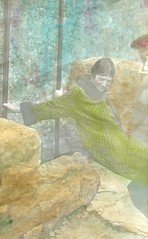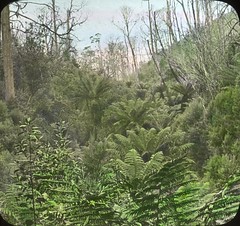The fully transcribed video of Dr. Roald Hoffmann’s presentation, “Indigo – A Story of Craft, Religion, History, Science and Culture,” is now available on the Special Collections & Archives Research Center website. Hoffmann’s talk was delivered in conjunction with his receipt of the Linus Pauling Legacy Award, presented in Portland on April 19, 2012.
A packed house of some three-hundred people was thoroughly engrossed by Hoffmann’s lecture, which lent credence to the professor’s reputation as a talented speaker. In tracing the historical development of indigo, Hoffmann first noted that Hebrew scripture has required, from very early on, that a small tassle of the garments worn by observant Jewish males be dyed blue. For generations this decree presented something of a problem in that the only known source of indigo in ancient times was the gland of a specific type of Mediterranean snail – 10,000 of which were required to produce a single gram of dye.
As technologies advanced, various plant species were discovered that could produce a similar shade of blue. However, as Hoffmann noted, the world would need to be completely covered with indigo plants ten feet high to color the 2-3 billion pairs of blue jeans now thought to be produced each year. Hoffmann used this statistic to expound upon the power of chemistry and its ability to create synthetic forms of the dye.
Dr. Hoffmann was the fourth Nobel laureate to receive the Legacy Award and the seventh honoree overall. Previous awardees include chemists Roger Kornberg, Roderick MacKinnon and Jack Roberts, and biologist Matthew Meselson.
Two other lectures, both by past OSU Libraries Resident Scholars, are also now freely available online.
“The Useful Science of Paul Emmett,” given by Dr. Burtron Davis of the University of Kentucky, discusses Davis’ ongoing research in support of a biography of Emmett (1900-1985), who is remembered today as the “Dean of Twentieth-Century Catalysis Chemistry.”
Emmett is recalled by Davis – once a post-doctoral student of Emmett’s – to have been a kind and talented man who enjoyed a long and distinguished career. Best known for his formulation, with Stephen Brunaur and Edward Teller, of the BET equation, (which Davis calls “Nobel quality work”) Emmett also made major contributions to the scientific understanding of ammonia synthesis and the Fischer-Tropsch process. In reviewing these highlights of Emmett’s biography, Davis’ lecture provides both an overview of Emmett’s major scientific achievements while also lending a glimpse into Emmett’s habits and personality from one who knew him and has continued to study his work.
A second lecture, “Hidden in Plain Sight: The Life of Ava Helen Pauling,” was delivered by Oregon State University professor of history Dr. Mina Carson, who is writing a biography of Ava Helen. Carson’s talk, which was given in late 2009, reflects her thinking at that time as she developed the framework of her book, which will be published in 2013.
At the time, she noted that attempting to write the life of Ava Helen Pauling forces the biographer to confront a number of difficult questions. Perhaps the most vexing is this: how does the biographer write the life of a wife? In particular, a wife who enjoyed her own world-changing career but whose life and work were inseparably fused with, and in many ways dependent upon, her husband’s work and fame? In ruminating on these topics, Carson also reflects on the major choices that Ava Helen made at critical points in her life as she sought to clarify her own interests and identity.
These three releases comprise only the latest additions to the large cache of digitized video available on the SCARC website. The full list of contents is available here.










